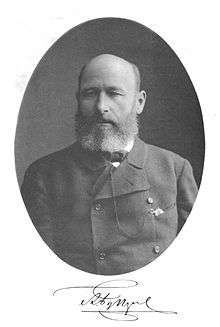Alexander Butlerov
"Butlerov" redirects here. For the lunar crater, see Butlerov (crater).
| Alexander Mikhaylovich Butlerov | |
|---|---|
 Alexander Butlerov | |
| Born |
15 September 1828 Chistopol, Kazan Governorate, Russian Empire |
| Died |
17 August 1886 (aged 57) Butlerovka, Kazan Governorate, Russian Empire |
| Nationality | Russian |
| Fields | Chemistry |
| Institutions | University of St. Petersburg, Kazan State University |
| Alma mater | Kazan State University |
| Doctoral advisor | Nikolay Zinin |
| Doctoral students | Alexey Yevgrafovich Favorsky, Vladimir Markovnikov, Alexander Mikhaylovich Zaytsev |
Alexander Mikhaylovich Butlerov (Алекса́ндр Миха́йлович Бу́тлеров; 15 September 1828 – 17 August 1886) was a Russian chemist, one of the principal creators of the theory of chemical structure (1857–1861), the first to incorporate double bonds into structural formulas, the discoverer of hexamine (1859), the discoverer of formaldehyde (1859) and the discoverer of the formose reaction (1861).
He first proposed the idea of possible tetrahedral arrangement of valence bonds in carbon compounds in 1862.[1]
The crater Butlerov on the Moon is named after him.
Alexander Butlerov was born in Chistopol into a landowning family.
-

1951 Alexander Butlerov USSR postage stamp
References
- ↑ "Jacobus Henricus van't Hoff". Chemical Heritage Foundation. Retrieved 18 November 2016.
- Leicester, Henry M. (1940). "Alexander Mikhailovich Butlerov". Journal of Chemical Education. 17 (May): 203–209. Bibcode:1940JChEd..17..203L. doi:10.1021/ed017p203.
- Arbuzov, B. A. (1978). "150th Anniversary of the birth of A. M. Butlerov". Russian Chemical Bulletin. 27 (9): 1791–1794. doi:10.1007/BF00929226.
- Rocke, Alan J. (1981). "Kekulé, Butlerov, and the Historiography of the Theory of Chemical Structure". British Journal for the History of Science. 14: 27–57. doi:10.1017/s0007087400018276.
- Bykov, G. V. (1982). "K istoriografii teorii khimicheskogo stroeniia". Voprosy istorii estestvoznaniia i tekhniki. 1982:4: 121–130.
- Brooks, Nathan (1998). "Alexander Butlerov and the Professionalization of Science in Russia". Russian Review. 57: 10–24. doi:10.1111/0036-0341.00004.
This article is issued from Wikipedia - version of the 11/20/2016. The text is available under the Creative Commons Attribution/Share Alike but additional terms may apply for the media files.